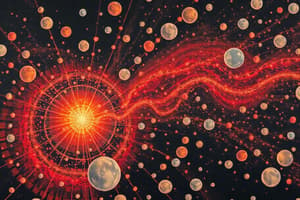Podcast
Questions and Answers
What significant contribution did Murray Gell-Mann make to the field of particle physics?
What significant contribution did Murray Gell-Mann make to the field of particle physics?
- He discovered the electron neutrino.
- He developed the theory of quantum entanglement.
- He isolated the first particle accelerator.
- He proposed a model categorizing different types of subatomic particles. (correct)
Which two main categories did Gell-Mann differentiate in his model of subatomic particles?
Which two main categories did Gell-Mann differentiate in his model of subatomic particles?
- Fermions and bosons (correct)
- Leptons and hadrons
- Quarks and leptons
- Baryons and mesons
What innovative concept did Gell-Mann introduce in relation to hadrons?
What innovative concept did Gell-Mann introduce in relation to hadrons?
- A new classification of leptons.
- The concept of a quark. (correct)
- The theory of gluons.
- A method for detecting neutrinos.
What visual tool associated with Richard Feynman is used to represent particle interactions?
What visual tool associated with Richard Feynman is used to represent particle interactions?
What recognition did Murray Gell-Mann receive for his contributions to physics?
What recognition did Murray Gell-Mann receive for his contributions to physics?
What was a significant feature of Feynman diagrams in quantum mechanics?
What was a significant feature of Feynman diagrams in quantum mechanics?
Which concept is attributed to Feynman in relation to nanotechnology?
Which concept is attributed to Feynman in relation to nanotechnology?
What aspect of physics did Feynman explore in relation to helium at absolute zero?
What aspect of physics did Feynman explore in relation to helium at absolute zero?
What was a notable part of Feynman's contribution during the Challenger disaster investigation?
What was a notable part of Feynman's contribution during the Challenger disaster investigation?
How does quantum mechanics, as described in the content, characterize its nature?
How does quantum mechanics, as described in the content, characterize its nature?
What conceptual innovation did Feynman use to enhance quantum electrodynamics?
What conceptual innovation did Feynman use to enhance quantum electrodynamics?
What fundamental aspect of particles is highlighted by Feynman diagrams?
What fundamental aspect of particles is highlighted by Feynman diagrams?
What major program was Feynman a part of during World War II?
What major program was Feynman a part of during World War II?
Which award did Richard Feynman receive in 1954 for his contributions to physics?
Which award did Richard Feynman receive in 1954 for his contributions to physics?
Which field did Feynman notably contribute to as a precursor to modern concepts in particle physics?
Which field did Feynman notably contribute to as a precursor to modern concepts in particle physics?
In which field did Feynman primarily make his most notable contributions?
In which field did Feynman primarily make his most notable contributions?
Which of the following experimental applications uses Feynman diagrams?
Which of the following experimental applications uses Feynman diagrams?
What phenomenon did Feynman explain regarding helium at absolute zero?
What phenomenon did Feynman explain regarding helium at absolute zero?
What educational institution did Feynman join as a professor in 1950?
What educational institution did Feynman join as a professor in 1950?
What was a notable feature of Feynman's lectures at Caltech published in 1964?
What was a notable feature of Feynman's lectures at Caltech published in 1964?
What challenge did Feynman face during his education at Columbia University?
What challenge did Feynman face during his education at Columbia University?
What type of particle interactions did QED, Feynman's significant work, explain?
What type of particle interactions did QED, Feynman's significant work, explain?
When did Feynman earn his Ph.D. degree?
When did Feynman earn his Ph.D. degree?
What year did Richard Feynman receive the Nobel Prize in Physics?
What year did Richard Feynman receive the Nobel Prize in Physics?
Which university did Richard Feynman attend for his undergraduate degree?
Which university did Richard Feynman attend for his undergraduate degree?
What was the primary focus of Richard Feynman's work during his appointment at Cornell University?
What was the primary focus of Richard Feynman's work during his appointment at Cornell University?
In what capacity did Richard Feynman contribute to the Manhattan Project?
In what capacity did Richard Feynman contribute to the Manhattan Project?
What notable achievement did Feynman accomplish at Princeton University?
What notable achievement did Feynman accomplish at Princeton University?
What distinguished Richard Feynman's lectures published in 1964?
What distinguished Richard Feynman's lectures published in 1964?
What significant mathematical difficulty was associated with early theories of quantum electrodynamics?
What significant mathematical difficulty was associated with early theories of quantum electrodynamics?
What year did Richard Feynman achieve appointment as a professor at the California Institute of Technology?
What year did Richard Feynman achieve appointment as a professor at the California Institute of Technology?
What major contribution did Murray Gell-Mann make to particle physics in 1964?
What major contribution did Murray Gell-Mann make to particle physics in 1964?
In Gell-Mann's classification system, what do bosons primarily function as?
In Gell-Mann's classification system, what do bosons primarily function as?
What validation solidified Gell-Mann's model and contributed to his receiving the Nobel Prize?
What validation solidified Gell-Mann's model and contributed to his receiving the Nobel Prize?
Which of the following correctly describes a primary characteristic of fermions according to Gell-Mann's classification?
Which of the following correctly describes a primary characteristic of fermions according to Gell-Mann's classification?
What was a unique aspect of Feynman diagrams as used by Richard Feynman?
What was a unique aspect of Feynman diagrams as used by Richard Feynman?
Flashcards are hidden until you start studying
Study Notes
Richard Feynman
- Richard Feynman was an exceptional physicist and teacher, adept at explaining complex concepts clearly.
- Feynman greatly impacted physics and technology with his work on quantum theory.
Milestones in Feynman's Life
- Feynman, a junior physicist, worked on the Manhattan Project at Los Alamos, New Mexico, in 1943.
- In 1950, he became a professor of theoretical physics at Caltech.
- Feynman received the Albert Einstein Award in 1954.
- His Caltech lectures were published in 1964 as "The Feynman Lectures on Physics."
- In 1965, he won the Nobel Prize in Physics for his work on quantum electrodynamics (QED).
Feynman's Early Life and Education
- Feynman, born in New York to Lithuanian Jewish parents, showed a strong aptitude for mathematics from a young age.
- He excelled at building gadgets and performing experiments.
- Feynman developed his own mathematical theories while still in high school.
- After being rejected from Columbia University, Feynman attended MIT, earning a degree in mathematics and later switching to physics.
- He earned a physics degree in 1939 specializing in quantum mechanics.
- Feynman received his doctorate in 1942.
Feynman's Work on the Atomic Bomb
- Feynman worked on the Manhattan Project at Los Alamos, New Mexico, during the 1940s, driven by the concern of a Nazi victory.
Feynman's Contributions to Quantum Mechanics
- Feynman's most significant work was in quantum electrodynamics (QED).
- QED describes how particles interact with electromagnetically charged particles through the exchange of photons (light packets).
- Feynman's work addressed challenges in the mathematical aspects of early QED theories.
- Feynman introduced Feynman diagrams, visual representations of electron and photon movement in space and time, including backward time movement.
- He further extended his contributions to quantum mechanics by illustrating the process of particles moving backward in time, a groundbreaking approach.
Feynman's Role in Nanotechnology and Superfluidity
- He envisioned "partons," which are now associated with the modern concept of quarks, the fundamental building blocks of matter.
- Feynman's ideas about "partons" laid the groundwork for later advancements in nanotechnology.
- Feynman researched superfluidity, where helium loses internal friction at absolute zero. This research sheds light on the behavior of matter at extreme temperatures.
The Challenger Disaster Investigation
- Feynman was involved in the investigation of the Challenger disaster in 1986.
- He used the analogy of ice water and a rubber band during his famous public demonstration to highlight the cause of the disaster.
Murray Gell-Mann's Contributions to Particle Physics
- Murray Gell-Mann possessed a wide range of talents, including fluency in languages, an aptitude for abstract thinking, and a profound understanding of particle physics.
- In 1964, he proposed a model to classify subatomic particles.
- His model proposed that particles are categorized as fermions (matter's building blocks) and bosons (force carriers).
- Gell-Mann introduced the notion of "quarks," hypothetical fundamental units, which compose hadrons (protons and neutrons).
- These ideas were confirmed through particle accelerator experiments, which isolated quarks.
- Gell-Mann's particle classification model, known as the Standard Model, earned him the 1969 Nobel Prize in Physics.
Feynman Diagrams
- Feynman diagrams are visual representations of abstract physics concepts.
- They are visually engaging and often described as charming squiggles.
- Feynman himself decorated his RV with Feynman diagrams.
- His Caltech lectures were transformed into a popular textbook called "The Feynman Lectures on Physics."
Studying That Suits You
Use AI to generate personalized quizzes and flashcards to suit your learning preferences.





